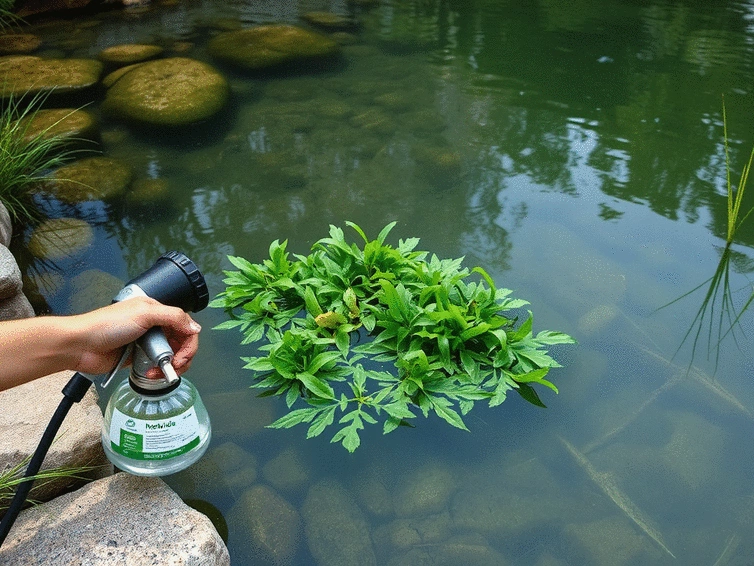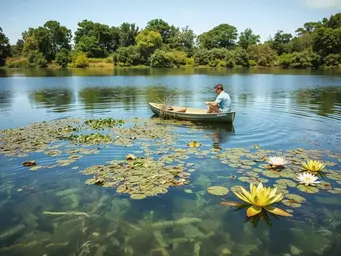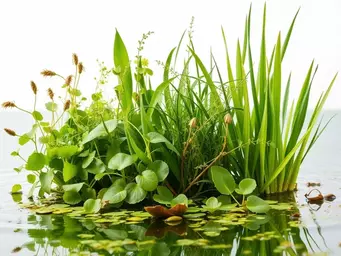Identify Target Weed Species
Knowing the exact weed helps choose the most effective herbicide, preventing harm to non-target plants.

Did you know that a single invasive plant species can drastically alter the ecosystem of a lake? Understanding aquatic weed management is essential not just for controlling these invaders, but for preserving the delicate balance of our waterways. Here’s what you’ll learn about effective practices in this vital area.
Understanding these crucial factors ensures effective weed management and ecological balance.
Knowing the exact weed helps choose the most effective herbicide, preventing harm to non-target plants.
Different water environments (lakes, rivers, ponds) require specific herbicide formulations and application methods.
Consider water chemistry, temperature, and potential impact on local aquatic life and ecosystems.
How the herbicide works determines its efficacy and potential side effects on the aquatic environment.
Ensure selected herbicides meet all local, state, and federal guidelines for aquatic application.
Aquatic weed management is essential for maintaining healthy ecosystems in our lakes and rivers. It involves the strategic identification and control of invasive plant species that threaten biodiversity and water quality. By effectively managing these weeds, we can restore balance to aquatic environments, fostering thriving habitats for fish and other wildlife. The goal is to empower landowners and waterway managers with the knowledge and tools needed for sustainable management practices.
At Aquatic Weed Solutions, we know that understanding the ins and outs of aquatic weed management is crucial. This includes not just identifying what the weeds are but how to control them effectively. Whether you’re dealing with an infestation of hydrilla or water hyacinth, our resources can guide you through the process of managing these invasive species.
Aquatic weed management encompasses a range of practices aimed at controlling unwanted plants in water bodies. These practices can include mechanical removal, biological control, and the use of herbicides. Each method has its advantages and is often chosen based on the specific conditions of the waterway and the type of weed present.
Understanding these methods helps landowners make informed choices about managing their waterways. For instance, mechanical removal can be effective for small infestations, while herbicides might be necessary for more extensive growths.
Choosing the right herbicide is critical for successful aquatic weed management. The effectiveness of herbicides can vary significantly depending on the target species, water chemistry, and environmental conditions. Using the wrong product can lead to ineffective control and may harm non-target species or the aquatic ecosystem itself.
At Aquatic Weed Solutions, we advocate for a thorough evaluation of your specific water conditions before deciding on a treatment method. This ensures not only the success of your management efforts but also the health of the surrounding ecosystem.
Aquatic ecosystems play a vital role in the health and balance of our waterways. They provide essential habitats for a variety of species and contribute to the water cycle. When managing aquatic weeds, it’s important to consider how these ecosystems function and how invasive species disrupt that balance.
By taking a holistic approach to aquatic weed management, we can preserve the integrity of aquatic ecosystems while effectively controlling invasive species. This not only enhances biodiversity but also promotes healthier waterways for future generations.
When selecting herbicides for aquatic weed management, always conduct a thorough assessment of your waterbody's specific conditions. Factors such as water chemistry and the presence of non-target species can significantly influence the effectiveness of your chosen herbicide. This careful evaluation not only enhances your management efforts but also protects the health of the aquatic ecosystem.
When it comes to selecting the right herbicide for aquatic weed management, several key considerations can guide your decision-making process. Understanding your target weed species, assessing the specific waterbody environment, and considering the broader ecological impacts are essential steps to ensure effective control. Each of these factors plays a crucial role in how your chosen herbicide performs.
Additionally, being aware of the herbicide's mode of action and its safety profile helps in aligning your management practices with ecological sustainability. In our quest for ecological balance at Aquatic Weed Solutions, we emphasize that informed choices lead to better outcomes for both the environment and your aquatic management efforts.
By taking these factors into account, you can tailor your approach to aquatic weed management to enhance both effectiveness and ecological health. Remember, the journey toward a balanced aquatic ecosystem is a collaborative effort, and I encourage you to stay engaged with local experts and the community.
In wrapping up, it’s clear that sustainable aquatic weed management is not just about using herbicides; it’s about integrating them into a broader strategy that considers ecological balance. At Aquatic Weed Solutions, I believe that education and empowerment play crucial roles in this process. By promoting awareness and responsible practices, we can work together to create healthier waterways.
As stewards of our aquatic environments, let’s continue to share knowledge, support one another, and strive for approaches that respect natural ecosystems. Together, we can achieve lasting results that benefit our lakes, rivers, and the communities that rely on them!
To further enhance your knowledge and skills in managing aquatic weeds, consider exploring various resources available through Aquatic Weed Solutions. We offer comprehensive guides, workshops, and online materials tailored for landowners, waterway managers, and ecologists.
Here are some key resources you might find valuable:
Partnering with local experts can significantly enhance your aquatic weed management efforts. Here’s how you can get started:
Seek out licensed applicators who have experience with aquatic herbicides. They can provide tailored advice based on local conditions and weed species present in your waterways.
Engaging in community initiatives focused on aquatic health can be incredibly rewarding. These programs often facilitate collaboration and knowledge sharing, strengthening our collective efforts.
Finally, consider contributing to public education efforts. Sharing what you’ve learned with friends and neighbors can help raise awareness, leading to better community practices in aquatic weed management.
Here is a quick recap of the important points discussed in the article:
Managing Aquatic Weeds Effectively

As we delve into the hidden challenges of our water ecosystems, understanding the role of aquatic we
Impact of Aquatic Weeds on Recreation

As we dive into the world of aquatic ecosystems, the presence of invasive aquatic weeds may not only
Understanding Aquatic Weed Varieties

What if understanding aquatic weeds could be the key to restoring our waterways? As we dive deeper i
Managing Aquatic Weeds Effectively
Impact of Aquatic Weeds on Recreation
Understanding Aquatic Weed Varieties
Integrated Aquatic Weed Management Methods
Integrated Approaches to Aquatic Weeds